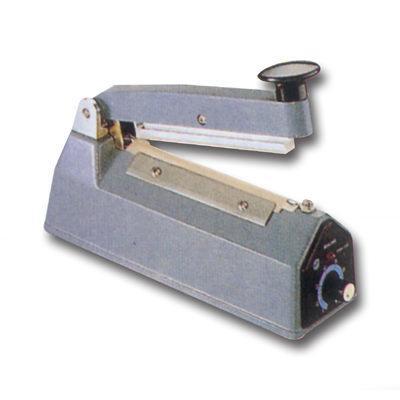Heat Sealing Machine

Hand Impulse Heat Sealer
Impulse sealers, a common type of hand-held sealer, only generate heat when the sealing bar is pressed, making them safer and more energy-efficient. Our plastic bag sealing machine is lightweight and easy to use. Simply place the bag onto the sear bar, press the handle, and release! The poly bag sealer safely uses heat and pressure to make airtight, watertight seals through wrinkles, gussets, and multiple film layers. This machine also has an adjustable timer that automatically presets the wielding time, giving you the perfect seal every time, regardless of bag thickness. All heat sealers from RoyalBag have an unmistakably solid construction for stability and accuracy.
Seal width is 5MM, other widths available upon request
Easy to Operate: Set the timer; insert the bag between the sealing bars, then press down and release. We recommend that the user hold the sealing arm down for an additional second or two to ensure enough time for the bag to set and cool.
- Light, portable - Fits comfortably on any table
- Fast impulse sealing of all types of plastic bags- including many laminates
- Seals thin as well as thick materials
- Just plug in and use, no warm up needed
- Durable and economical
- Plug-in electronic timer for variable control
| Name | Case of | Price | ||
|---|---|---|---|---|
|
Reg. Sale: As low as: |
Out of stock Expected date: Notify me |
|||
|
Reg. Sale: As low as: |
Our FS-Series impulse hand sealers seal poly bags and other thermoplastic materials quickly and efficiently without any warm-up time. Depending on the model of the machine, materials up to 20” wide and 20mil total thickness can be sealed. FS-Series impulse sealers are available in available in 4”, 8”, 12”, 16”, and 20” with a 2mm , 3mm or 5mm seal width. Manufacturers’ kit includes two elements, two PTFE covers
Our hand-held impulse heat sealers are a compact, portable device designed to seal plastic bags and other packaging materials using heat. Here's a breakdown of how they work and their key features:
Some of the industries that use hand sealers:
Safety Precautions:
Be aware of the hot sealing surfaces, especially with constant heat sealers, to avoid burns.
Only use the necessary amount of heat for the material being sealed.
Ensure adequate training and education for all users.
Keep the sealing area clear of flammable materials and debris.
Regularly inspect the sealer for any damage or malfunctions.






